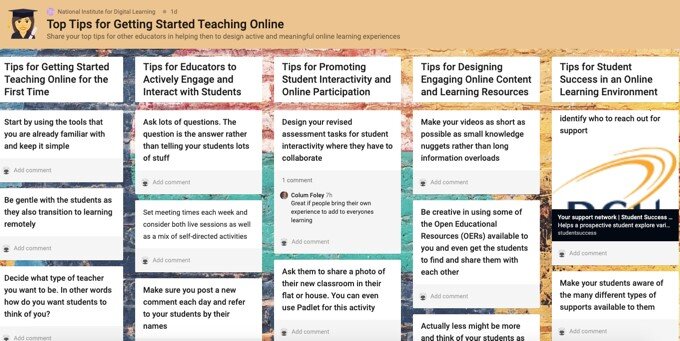360 photography
https://tours.bemorecolorful.com/v/7R81yaZ91Ad
++++++++++++++
more on 360 in this IMS blog
https://blog.stcloudstate.edu/ims?s=360
Digital Literacy for St. Cloud State University
https://tours.bemorecolorful.com/v/7R81yaZ91Ad
++++++++++++++
more on 360 in this IMS blog
https://blog.stcloudstate.edu/ims?s=360
There is also a sharp political divide in how concerned parents are about the impact of the coronavirus on their children’s education, a Gallup survey shows. https://t.co/4I5bglvZfJ
— Education Week (@educationweek) April 10, 2020
Two important caveats: The ability to access the internet is crucial for the survey respondents. And the poll has a relatively significant margin of error.
The coronavirus pandemic has forced the vast majority of schools nationwide to close for several weeks; several states and U.S. territories have closed their schools’ doors for the rest of the 2019-20 academic year. At the same time, states and districts have rushed to get remote learning sessions up and running, with varying success.
++++++++++++
more on education and politics in this IMS blog
https://blog.stcloudstate.edu/ims?s=education+politics
#twitterstorians, in the fall, I’m teaching a course called “Fake History,” which will explore commonly held myths and lies about the past. What myth/lie/misconception about the past troubles, irks, annoys, or bothers you the most? (I’m trying to figuring out what I’m missing)
— Eladio Bobadilla (@e_b_bobadilla) April 9, 2020
++++++++++++++
more on history in this IMS blog
https://blog.stcloudstate.edu/ims?s=history
Very useful set of visuals in easy-to-browse format, with links to explore. “What’s Happening With State Budgets and #HigherEd” https://t.co/Mk9rjztXQa
— Robin DeRosa (@actualham) April 8, 2020
+++++++++++++
more on finances in higher ed in this IMS blog
https://blog.stcloudstate.edu/ims?s=higher+ed+finances
Augmented Reality + Videoconferencing: meet together virtually in the same place, collaborate and communicate as if you were there. Demo below, links to try it yourself to follow! pic.twitter.com/AbZAof0cJ5
— SpatialFirst (@SpatialFirst) April 8, 2020
++++++++++
more on augmented reality in this IMS blog
https://blog.stcloudstate.edu/ims?s=augmented+reality
Responding to Covid-19: The Good, the Bad and the Ugly of Teaching Online — https://t.co/QdOaYLOQGR pic.twitter.com/eLANBFpkwp
— Ana Cristina Pratas (@AnaCristinaPrts) April 9, 2020
https://www.icde.org/icde-blog/2020/3/26/responding-to-covid-19
Importantly, today’s educators in the digital-era have a range of new teaching methods, activities and resources they can consider when choosing their learning designs. Although the traditional face-to-face lecture is not dead, delivering a monologue for an hour to a passive audience of learners is hardly the gold standard of good teaching in the 21st Century–irrespective of delivery mode. This point should not be overlooked in the rush to replace conventional teaching with live online sessions using platforms like Zoom.

Most importantly, what we want to avoid is using old 19th Century teaching methods on new 21st Century technologies to merely dump large volumes of undigested information down large digital diameter pipes to relatively inactive and passive learners.
ICDE has a series of forthcoming webinars you can join and you will find around a dozen different types of online course offerings available right now for educators on our NIDL Resource Bank.
+++++++++++++++
more on distance education in this IMS blog
https://blog.stcloudstate.edu/ims?s=distance+education
+++++++++++++Formative Assessment in Distance Learning https://t.co/QUPWB2sA15 #education #edchat #k12 #remotelearning #assessment #thriveinedu #edcovid #edutwitter #distancelearning #edtech
— Rachelle Dene Poth #ThriveinEDU #AI #ARVR (@Rdene915) April 8, 2020
https://www.edutopia.org/article/formative-assessment-distance-learning
Whether we use synchronous or asynchronous online sessions, whether we call it distance or virtual learning, we’re all challenged to provide meaningful education experiences at a distance as the education world grapples with the impact of Covid-19.
Know your purpose
Collect data over time
Focus on feedback
Check for understanding in synchronous sessions
Leverage personal conversations
Check in on SEL
Make it useful
+++++++++++++++++++
+++++++++++++++++
formative assessment in this IMS blog
https://blog.stcloudstate.edu/ims?s=formative+assessment
this faculty group conversation is the result of the Zoom issues lately:
Hi everyone, I’m looking for a video conferencing tool/platform that does not need to be downloaded onto a student device (the way that Zoom does, so no Zoom), and operates through a website or in the cloud. It needs to be safe, student friendly, and can accommodate a group of 20, also needs to be able to be used with an iPad. Thoughts? Much appreciated.
8×8.vc https://8×8.vc/ – doesn’t work on safari but chrome/firefox on laptops. on mobile, you’ll need to download the 8×8 Video Meetings app. I’ve used it with over 60 people and it works just fine. If you pick a sufficiently random room name that will stop anyone from guessing it and jumping in. It has screen sharing, call in ability. You can’t kick anyone and if you mute people, they can unmute themselves… there is no “host” but it works pretty well for what I’ve needed lately.
Online Tools for Teaching & Learning – Designed by students in EDUC 595A at the University of Massachusetts Amherst https://t.co/FZ9eAZQGlA pic.twitter.com/BKToe9vjUl
— Ana Cristina Pratas (@AnaCristinaPrts) April 8, 2020
https://blogs.umass.edu/onlinetools/
National Research Council’s (2000) four types of learning environments: assessment-centered, community-centered, knowledge-centered, and learner-centered.
++++++++++++++++
more on online education in this IMS blog
https://blog.stcloudstate.edu/ims?s=online+education
https://www.edsurge.com/news/2020-03-09-how-to-effectively-use-ar-and-vr-apps-with-young-learners
The error I see many beginning to make is forgetting about the diverse needs of our younger students or, worse, pushing tools intended for older students on younger ones. When considering immersive technology resources for our early elementary students, I’ve shared some important, practical areas to keep in mind.
++++++++++
more on VR in this IMS blog
https://blog.stcloudstate.edu/ims?s=vr